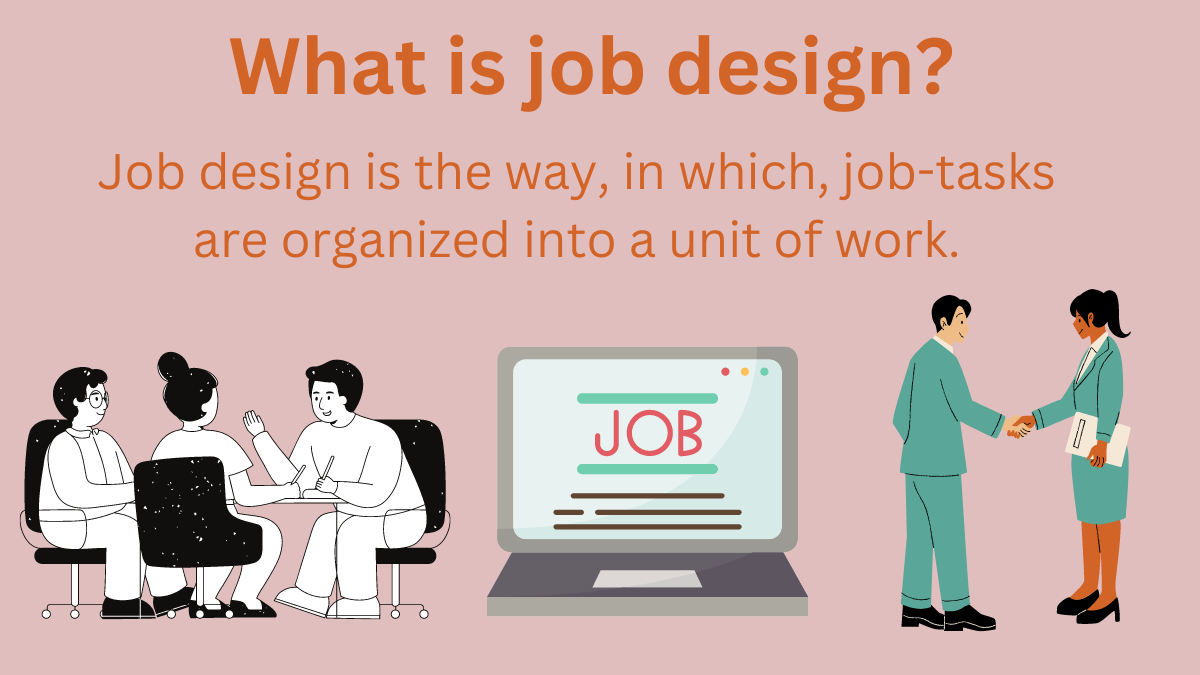What is job design?
Job design is the way that the tasks are combined to form a complete job. It is the process of determining a specific task to be included in a job. Job design is the structuring of jobs to improve an organization’s efficiency and employee job satisfaction. It is concerned with changing and modifying jobs to utilize the talents of the employees. Human resource managers have realized that an important factor influencing these areas is the type of work handled by the employee. Job design answers the questions of how the job is to be performed.
Job design refers to the process of structuring and organizing tasks, duties, and responsibilities within a job to enhance productivity, efficiency, satisfaction, and employee well-being. It involves determining the content and layout of a job, including factors such as task variety, autonomy, skill variety, and feedback mechanisms, to create roles that align with organizational objectives and meet the needs of both employees and employers.
According to Mathis and Jackson, “Job design refers to organizing tasks, duties, and responsibilities into a productive unit of work.”
According to DeCenzo and Robbins, “Job design is the way, in which, job-tasks are organized into a unit of work.”
Finally, the goal of the job design is to integrate the needs of the individual with the organizational requirements. Therefore, job design has a significant impact on both the employees and the organization.
Benefits/Importance of Job Design
Job designs satisfy the individual and help to accomplish organizational goals. Therefore, it has a significant impact on employees. The job design provides the following benefits:
Job satisfaction
Employees are more satisfied with certain job arrangements than randomly arranged ones. It can affect their job satisfaction. Therefore, it is important to identify what makes a good job for them.
Motivation
Job design can influence employees’ performance. Jobs should be designed in such a way that it makes them interesting and challenging. Employee motivation can lower the cost, and reduce turnover, and absenteeism. Higher motivation leads to higher productivity.
The right person in the right position
Job design helps to fit between job and person. It involves matching the characteristics of employees with the characteristics of the job. If a person does not fit a job, he should be changed or replaced.
Quality of work life
Job design is useful for improving the quality of work life at work. Jobs can be made more challenging and rewarding by redesigning jobs. This can help employees in growth and development. It has a positive impact on both the physical and mental health of the employees.
Higher performance
A proper job design teaches employees about techniques and ways to perform the job. Employees can contribute their efficiency to the organizational goal achievement. Therefore, employees’ performance can be increased with proper job design, which also contributes to higher productivity.
Methods/Strategies/Approaches of Job Design
Several factors should be taken into consideration while designing a job. The methods of job design are as follows:

Work simplification method
In this method, a job is broken down into small parts and tries to gather similar tasks in one category. In this way, the job is simplified or specialized so that one employee can perform this job easily and get specialized knowledge by doing it regularly.
Job rotation method
Job rotation means shifting people from one job to another within a working group. In this method, jobs are similar but employee has to move from job to job. Jobs themselves are not changed; only the employees are rotated among various jobs. The advantages of this method are that it reduces boredom and monotony of a job and provides opportunities to learn other jobs. However, job rotation decreases in productivity.
Job enlargement method
Job enlargement involves broadening the job by expanding the number of different tasks to be performed. There will be a horizontal expansion of the job. Job enlargement serves to increase variety, lengthen work cycle time, and increase the knowledge necessary to perform it. Enlarged jobs require longer training periods because there are more tasks to be learned.
Job enrichment method
Job enrichment means increasing the responsibility, scope, and challenge in the work. It leads to a vertically enhanced job by adding functions and containing more variety and challenges. Job enrichment is a motivational technique, that emphasizes the need for challenging and interesting work.
Team method
Jobs can also be designed for teams. More organizations are using teams of employees instead of individuals for jobs. Some strategic goals are formulated which are supposed to be accomplished by a team. A team may consist of multiple skills so that this team can perform a variety of job tasks. Highly effective teams are composed of groups of committed individuals who trust each other.
Modified work schedule
Job design can also be determined by changing work scheduling. One of the scheduling methods is shorter week work. In this, the number of days in the work week is shortened by lengthening the number of hours worked per day. Some employees may feel autonomy and commitment to their work if they are allowed to work as they want. This also results in job satisfaction, facilitates personal appointments, and coordinates employees’ work schedules with production schedules. The next step in the scheduling methods of flextime. Job design can be determined by providing the flexible time that employees require.
